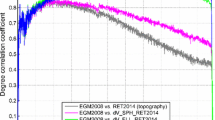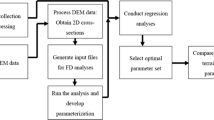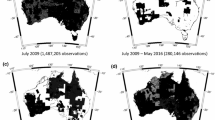Abstract
Classical degree variance models (such as Kaula’s rule or the Tscherning-Rapp model) often rely on low-resolution gravity data and so are subject to extrapolation when used to describe the decay of the gravity field at short spatial scales. This paper presents a new degree variance model based on the recently published GGMplus near-global land areas 220 m resolution gravity maps (Geophys Res Lett 40(16):4279–4283, 2013). We investigate and use a 2D-DFT (discrete Fourier transform) approach to transform GGMplus gravity grids into degree variances. The method is described in detail and its approximation errors are studied using closed-loop experiments. Focus is placed on tiling, azimuth averaging, and windowing effects in the 2D-DFT method and on analytical fitting of degree variances. Approximation errors of the 2D-DFT procedure on the (spherical harmonic) degree variance are found to be at the 10–20 % level. The importance of the reference surface (sphere, ellipsoid or topography) of the gravity data for correct interpretation of degree variance spectra is highlighted. The effect of the underlying mass arrangement (spherical or ellipsoidal approximation) on the degree variances is found to be crucial at short spatial scales. A rule-of-thumb for transformation of spectra between spherical and ellipsoidal approximation is derived. Application of the 2D-DFT on GGMplus gravity maps yields a new degree variance model to degree 90,000. The model is supported by GRACE, GOCE, EGM2008 and forward-modelled gravity at 3 billion land points over all land areas within the SRTM data coverage and provides gravity signal variances at the surface of the topography. The model yields omission errors of \(\sim \)9 mGal for gravity (\(\sim \)1.5 cm for geoid effects) at scales of 10 km, \(\sim \)4 mGal (\(\sim \)1 mm) at 2-km scales, and \(\sim \)2 mGal (\(\sim \)0.2 mm) at 1-km scales.













Similar content being viewed by others
References
Abrykosov O, Förste C, Gruber C, Shako R, Barthelmes F (2012) Harmonic analysis of the DTU10 global gravity anomalies. In: Abbasi A, Giesen N (eds) EGU General Assembly Conference Abstracts, EGU General Assembly Conference Abstracts, vol 14, p 4945
Balmino G, Vales N, Bonvalot S, Briais A (2012) Spherical harmonic modelling to ultra-high degree of Bouguer and Isostatic anomalies. J Geod 86(7):499–520. doi:10.1007/s00190-011-0533-4
Claessens S, Hirt C (2013) Ellipsoidal topographic potential—new solutions for spectral forward gravity modelling of topography with respect to a reference ellipsoid. J Geophys Res 118(11):5991–6002. doi:10.1002/2013JB010457
Dahlen FA, Simons FJ (2008) Spectral estimation on a sphere in geophysics and cosmology. Geophys J Int 147:774–807. doi:10.1111/j.1365-246X.2008.03854.x
Farr T, Rosen P, Caro E, Crippen R, Duren R, Hensley S, Kobrick M, Paller M, Rodriguez E, Roth L, Seal D, Shaffer S, Shimada K, Umland J, Werner M, Oskin M, Burbank D, Alsdorf D (2007) The Shuttle Radar Topography Mission. Rev Geophys 45(RG2004). doi:10.1029/2005RG000183
Flury J (2006) Short-wavelength spectral properties of the gravity field from a range of regional data sets. J Geod 79:624–640. doi:10.1007/s00190-005-0011-y
Forsberg R (1984a) Local covariance functions and density distribution. OSU Report 356, Ohio State University
Forsberg R (1984b) A study of terrain reductions, density anomalies and geophysical inversion methods in gravity field modelling. OSU Report 355, Ohio State University
Grombein T, Luo X, Seitz K, Heck B (2014) A wavelet-based assessment of topographic-isostatic reductions for GOCE gravity gradients. Surv Geophys 1–24. doi:10.1007/s10712-014-9283-1
Gruber C, Abrikosov O (2014) High resolution spherical and ellipsoidal harmonic expansions by Fast Fourier Transform. Studia Geophysica et Geodaetica 58. doi:10.1007/s11200-013-0578-3 (online first)
Heller W, Jordan S (1976) A new self-consistent statistical gravity field model. In: Eos Trans. AGU Fall Meeting, San Francisco, vol 75, p 895
Hirt C (2012) Efficient and accurate high-degree spherical harmonic synthesis of gravity field functionals at the Earth’s surface using the gradient approach. J Geod 86(9):729–744. doi:10.1007/s00190-012-0050-y
Hirt C, Kuhn M (2012) Evaluation of high-degree series expansions of the topographic potential to higher-order powers. J Geophys Res Solid Earth 117. doi:10.1029/22012JB009492
Hirt C, Kuhn M (2014) A band-limited topographic mass distribution generates a full-spectrum gravity field—gravity forward modelling in the spectral and spatial domain revisited. J Geophys Res Solid Earth 119. doi:10.1002/2013JB010900
Hirt C, Kuhn M, Claessens SJ, Pail R, Seitz K, Gruber T (2014) Study of the Earth’s short-scale gravity field using the ERTM2160 gravity model. Comput Geosci 73:71–80. doi:10.1016/j.cageo.2014.09.00
Hirt C, Featherstone W, Marti U (2010) Combining EGM2008 and SRTM/DTM2006.0 residual terrain model data to improve quasigeoid computations in mountainous areas devoid of gravity data. J Geod 84(9):557–567. doi:10.1007/s00190-010-0395-1
Hirt C, Claessens S, Fecher T, Kuhn M, Pail R, Rexer M (2013) New ultra-high resolution picture of Earth’s gravity field. Geophys Res Lett 40(16):4279–4283. doi:10.1002/grl.50838
Holmes S, Pavlis N (2008) EGM Harmonic Synthesis Software. National Geospatial-Intelligence Agency. http://earth-info.nga.mil/GandG/wgs84/gravitymod/newegm/newegm.html
Jekeli C (1978) An investigation of two models for the degree variances of global covariance functions. OSU report 275, Department of Geodetic Science, Ohio State University
Jekeli C, Yanh HJ, Kwon JH (2009) Evaluation of EGM08—globally and locally in South Korea. Newton’s Bull 38–49
Jekeli C (2010) Correlation modeling of the gravity field in classical geodesy. In: Freeden W, Nashed M, Sonar T (eds) Handbook of the Geomathematics. Springer, Berlin Heidelberg. doi:10.1007/978-3-642-01546-528
Kaula W (1966) Theory of satellite geodesy. Blaisdel, Waltham
Kuhn M, Seitz K (2005) Comparison of Newton’s integral in the space and frequency domains. In: Sanso F (ed) A window on the Future of Geodesy—IAG Symposia, vol 128, pp 386–391
Mayer-Gürr T, Kurtenbach E, Eicker A (2010) ITG-Grace2010 gravity field model. www.igg.unibonn.de/apmg/index.php?id=itg-grace2010
Moritz H (1977) On the computation of a global covariance model. OSU 255, Department of Geodetic Science, Ohio State University
Moritz H (2000) Geodetic reference system 1980. J Geod 74(1):128–162. doi:10.1007/s001900050278
Novak P (2010) Direct modelling of the gravitational field using harmonic series. Acta Geodyn Geomater 7(1):35–47
Pail R, Goiginger H, Mayrhofer R, Schuh WD, Brockmann JM et al (2010) GOCE gravity field model derived from orbit and gradiometry data applying the Time-Wise Method. Proc ESA Living Planet Symp 28 June–2 July (ESA SP-686)
Pail R, Bruinsma S, Migliaccio F, Förste C, Goiginger H, Schuh WD, Höck E, Reguzzoni M, Brockmann JM, Abrikosov O, Veicherts M, Fecher T, Mayrhofer R, Krasbutter I, Sanso F, Tscherning CC (2011) First GOCE gravity field models derived by three different approaches. J Geod 85(11):819–843. doi:10.1007/s00190-011-0467-x (special issue: “GOCE - The Gravity and Steady-state Ocean Circulation Explorer”)
Papoulis A (1984) Signal analysis. McGraw-Hil Book Company
Pavlis NK, Rapp RH (1990) The development of an isostatic gravitational model to degree 360 and its use in global gravity modelling. Geophys J Int 100:369–378. doi:10.1111/j.1365-246X.1990.tb00691.x
Pavlis N, Factor J, Holmes S (2007) Terrain-related gravimetric quantities computed for the next EGM. In: Dergisi H (ed) Proceedings of the 1st International Symposium of the International Gravity Field Service, vol 18, pp 318–323
Pavlis N, Holmes S, Kenyon S, Factor J (2012) The development and evaluation of the Earth Gravitational Model 2008 (EGM2008). J Geophys Res 117. doi:10.1029/2011JB008916
Rexer M, Hirt C (2014) Comparison of free high resolution digital elevation data sets (ASTER GDEM2, SRTM v2.1/v4.1) and validation against accurate heights from the Australian National Gravity Database. Aust J Earth Sci 1–15. doi:10.1080/08120099.2014.884983. http://www.tandfonline.com/doi/abs/10.1080/08120099.2014.884983
Rummel R, Rapp R, Sünkel H, Tscherning C (1988) Comparisons of global topographic/ isostatic models to the Earth’s observed gravity field. OSU report 388, Ohio State University
Sanso F, Sideris M (2013) Geoid determination—Lecture Notes in Earth Sciences, vol 110 (chap Harmonic Calculus and Global Gravity Models). Springer, Berlin Heidelberg
Sneeuw N (1994) Global spherical harmonic analysis by least-squares and numerical quadrature methods in historical perspective. Geophys J Int 118(3):707–716. doi:10.1111/j.1365-246X.1994.tb03995.x
Szücs E, Papp G, Benedek J (2014) A study of different wavelength spectral components of the gravity field derived from various terrestrial data sets. Acta Geodaetica et Geophysica. doi:10.1007/s40328-014-0061-9 (online first)
Tapley BD, Bettadpur S, Watkins M, Reigber C (2004) The gravity recovery and climate experiment: mission overview and early results. Geophys Res Lett 31:L09607. doi:10.1029/2004GL019920
Torge W (2001) Geodesy, 3rd edn. Walter de Gruyter
Tscherning C, Rapp R (1974) Closed covariance expressions for gravity anomalies, geoid undulations, and deflections from the vertical implied by anomaly degree variance models. OSU report 208, Ohio State University
Vassiliou A, Schwarz K (1987) Study of the high-frequency spectrum of the anomalous potential. J Geophys Res 92(B1):609–617
Voigt C, Denker H (2007) A study of high frequency terrain effects in gravity field modelling. In: Dergisi H (ed) 1st International Symposium of the INternational Gravity Field Service, “Gravity Field of the Earth”, Ankara, Turkey, vol 18, pp 342–347
Wenzel H, Arabelos D (1981) Zur Schätzung von Anomalie-Gradvarianzen aus lokalen empirischen Kovarianzfunktionen. Zeitschrift für Vermessungswesen 106:234–243
Acknowledgments
With the support of the Technische Universität München—Institute for Advanced Study, funded by the German Excellence Initiative. We thank the Australian Research Council for funding via Grant DP120102441. We thank Roland Pail for sharing his knowledge on Fourier transforms, Reiner Rummel for directing us to Parseval’s theorem, and Sten Claessens for the discussions related to degree variances. We are grateful for very constructive and thorough reviews received from four anonymous reviewers, improving the clarity of presentation and stimulating future research.
Author information
Authors and Affiliations
Corresponding author
Rights and permissions
About this article
Cite this article
Rexer, M., Hirt, C. Spectral analysis of the Earth’s topographic potential via 2D-DFT: a new data-based degree variance model to degree 90,000. J Geod 89, 887–909 (2015). https://doi.org/10.1007/s00190-015-0822-4
Received:
Accepted:
Published:
Issue Date:
DOI: https://doi.org/10.1007/s00190-015-0822-4




